SoB Gutenburg and Printing Press
1/103
There's no tags or description
Looks like no tags are added yet.
Name | Mastery | Learn | Test | Matching | Spaced |
|---|
No study sessions yet.
104 Terms
What is incunabula?
Translates to cradle, the earliest form of printing
The earliest printing books tried to imitate what?
Handwriting styles that were originally produced by monks and scribes — it was so similar you could not tell they were printed
New print styles
Typeset
How did the printing press affect the production of books?
It sped up production
Cuneiform
The oldest form of writing developed by Ancient Sumerians in Mesopotamia
Used a stylus, a wedge-shaped tool, to make marks in clay.
Faded away when alphabets were developed around 100 BCE.
When was wood block printing invented, and by who?
The 3rd century by the Chinese and Koreans
What material was used for wood block printing instead of paper?
Cloth or silk
Woodblock printing steps
Carried out by using a chisel to carve characters onto woodblocks.
Ink was applied to the raised characters on the wood.
Pressed down a cloth on the block and then lifted it, printing the ink onto the cloth.
The woodblock continued to be used over and over as a template.
What was a benefit of woodblock printing?
It worked towards automation and speed as the first steps away from the Book of Hours and handwritten manuscripts
Problems with woodblock printing
If you make a mistake you can’t fix it once it’s carved
A lot of different letters
Woodblocks need to be laid out and kept in proper order
Not resistant to fire
Wood wears down over time
When was paper discovered?
7th century
Hanzi
The Chinese language that had over 100,000 characters
What did Koreans used to print characters in the 13th century, after woodblock printing?
Metal
European communication in the Middle Ages
Most people lived in and stayed in their small isolated villages, so the only sources of information were each other and the Catholic priest.
Almost no one could read or write the language they spoke.
Memory and memorization ruled daily life and learning, since people couldn’t read.
Even scholars literate in Latin used memory devices to remember what they had learned.
What did Johannes Gutenburg (capitalist supreme) accomplish?
He created the world’s first printed book using movable type — the Bible
What did Johannes Gutenburg learn from his father?
Coin production/printing
What did Gutenburg sell before he started the printing press?
Mirrors, to pilgrims who used them to capture the healing powers of holy objects
The plague
The outbreak caused Gutenburg’s mirror business to fail, and he moved on to a secret project. He wanted to invent a unique movable-type printing process
Did Gutenburg have to deal with a lot of characters?
No - he didn’t have to deal with thousands of Chinese characters – he only had to deal with 24-30 in the Latin alphabet, which is very important.
What did Gutenburg draw inspiration from for stamping?
Grape presses
Typeset
Different characters, sizes, and shapes
Movable typeset
Typeset that can be used over and over again for other projects
Tools for making typeset
The punch, matrix, and mould
The punch
Has a letter on top of it, formed by skilled workers who use chisels
Matrix
A softer metal piece that the punch would be hammered into
Mould
A mould that the matrix was locked in, then filled with hot metal and cooled to reveal the typeset letter
Paper and ink
Gutenburg used parchment and vellum at first because of low paper supply, but he found an ink composed of linseed oil and lampblack, and that paper had to be a certain thickness and slightly dampened for ink to stick properly
Indulgences
Printed for the Church, these were standardized forms used by Christians to donate money to the Catholic Church and be assured admission to Heaven. The money was used to fight off religious wars from eastern Europe
How did Gutenburg manage the costs of the printing press?
He borrowed money from many people, such as Johann Fust, one of his business partners
Why did Gutenburg decide to print the Bible?
Because the Holy Roman Empire was vast and wealthy
Most Bibles were printed using paper, but more expensive ones were printed using what?
Vellum
Blackletter/black letter gothic
The world’s first typeset (font style), used in the Gutenburg Bible
How did Gutenburg’s ink compare to ink that monks and scribes used?
It was thicker and oil-based
What did Gutenberg’s Bible consist of?
2 columns of print and 42 lines, more than 1,000 pages
What would you need to do if you wanted red ink or decorations?
You would need to press a page two times, and then artists would decorate after the pages were printed
The Gutenburg Bible was printed when?
1455
The Gutenburg Bible is our first example of …
incunabula: cradle/earliest days of early printing
Gutenberg’s Bible was produced in Latin from the _____
Vulgate
Because of Gutenberg, it now took three printers three months to produce three hundred books. It would take the scribes _____ to do the same
A lifetime
Individual leaves of Gutenberg’s Bible can be worth up to ____
$100,000
Did Gutenberg ever get rich?
No, he borrowed too much money and got sued
After about ___ years of the Gutenberg Bible, the amount of books printed skyrocketed from very few to twenty million.
50
Without the printing press, the _______ would have developed over a much slower and longer period of time.
Renaissance
Gor the next 500 years Gutenberg’s press and typeset would be used all over the world and only was only made outdated in the ______ century
19th
What was the Gutenburg Bible responsible for?
Spreading learning and education all over the world
Pullbar
Pulls down

Platen
Stamps the paper/vellum
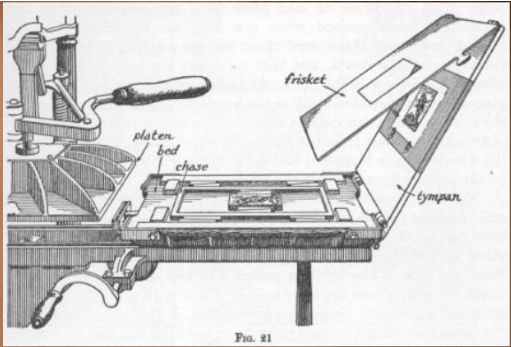
What’s in the middle of the table?
Typeset with metal around it
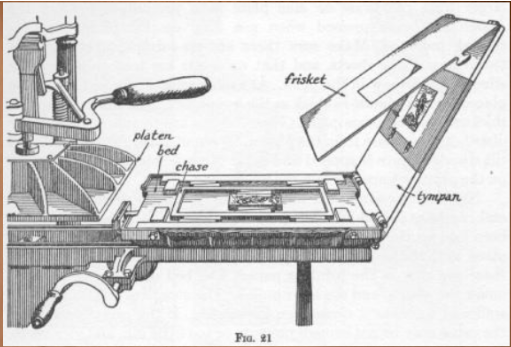
Frisket
Piece of paper cut into a square that meshes with the ink; leaves it exposed and keeps it from going all over
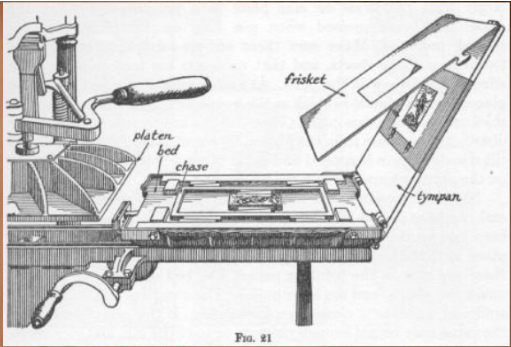
Key steps in the printing process
Print shop owner obtains the manuscript.
Next, all contractual issues are settled (authorship, etc.).
Typesetters and pressmen then take over and:
Read and probably argue over manuscript content (scribble).
Walk to the upper and lower case and select typeset.
Transfer what’s written to the composing stick backwards.
Set the type in the chase.
Allow space for illustrations if requested.
Obtain and set paper in printing press.
Ink up the typeset.
Pull the lever to print.
Remove paper and hang it to dry.
What does Blackletter typeface look like?
Dramatic thin and thick strokes, elaborate swirls on the serifs; based on early manuscript writings
Four major families of blackletters
Textura, Rotunda, Schwabacher, and Fraktur
Gutenburg’s typeset and Germany
Germany used Blackletters until the early 20th century; in the 1920s it was considered to be antiquated by German designers and publishers and fell out of favor, and was replaced by the “New Typography”
Hitler thought the new typography and declared Fraktur (a blackletter font) the people’s font
The Nazis used Fraktur until 1941
People associate all blackletters as Nazi fonts but this is not true
Gutenburg’s typeset today
Blackletters are mainly used for headings, logos, posters, and signs; usually used in certificates, diplomas, or degrees.
Rag paper
All paper before 1800 was made by hand. Rag paper was the first paper used by the Europeans, made of silks, cotton, and flannels.
Laid paper
Laid paper is made on a mould, which consists of a rectangular frame to which is attached a fine mesh of wires parallel to the long sides of the mold.
These fine wires are crossed by thicker wires, chain lines, that run parallel to the short sides of the mold
The wire lines (laid lines) and chain lines can be seen when the paper is held up to the light
Chain and wire lines
During the papermaking process, after the water
with suspended paper fibers had been evenly
distributed over the wire mesh of the mould, the
mould would then be inverted over a piece of felt
to deposit the new and very delicate piece of
paper there. This resulted in the paper having
two sides, a mould side, which had been next to
the wire mesh, and a felt side.
Mould and felt sides can sometimes be
determined by examining the paper closely, with
the mould side carrying the impression of the
wire and chain lines and the felt side being
smoother.
What is paper format?
The number of folds needed to make pages that go in a book
Why is paper format important?
Because printers don’t print just one page at a time; they print on several pages at once and then fold each sheet into a specified order
Folio
When two leaves (four pages when printed on both sides) were printed on a sheet
so that it could be folded once, collated with other folded sheets and bound
Quarto
When four leaves (eight pages) were printed on the same size sheet, which would later be folded twice
Octavo
A sheet with eight leaves printed on it.
Signatures
Each time a printer used a new piece of paper, he or she signed it with a printed signature in the lower part of the page. These signatures typically ran from A-Z, but omitting J, V, and M.
Signatures are counted using formulas...
Folio
When just two pages are printed side-by-side on both sides of a sheet which is later folded once, and then cut, resulting in two leaves, four pages, the book comprised of gatherings of these leaves is called a “folio” (which is written as 2° for short, or sometimes as “fo”).
Quarto
In this instance, each page of the book will be half the size of the sheets used in printing. And where sheets have been printed with the text of four pages per side, and then folded twice, a book has the format “quarto”, 4to or 4°. This sheet, folded one extra time, results in four leaves a quarter of the size of the original sheet.
Most common book formats
Folio and quarto
Watermark locations
Folio
Quarto
Octavo
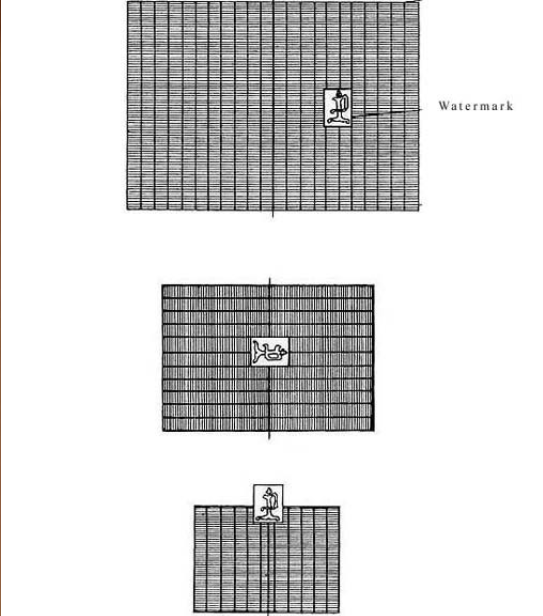
Broadsheet/broadside
A broadside is a large sheet with only one side printed; a
“broadsheet” (“1o”) might be printed on whole sheets, which
would produce horizontal chainlines with both a watermark and
(if present) a countermark on each sheet. If printed “two-up”
or two-at-a-time on sheets of large stock and cut in half, the
chain lines of the broadsheet would run vertically and some
sheets would have a watermark in their middle, and others
would have the countermark in the middle, but they would not
have been folded and sewn, though they might have been
folded for storage (with no sewing holes, to distinguish them
from folded loose sheets from a folio edition that was broken
up)
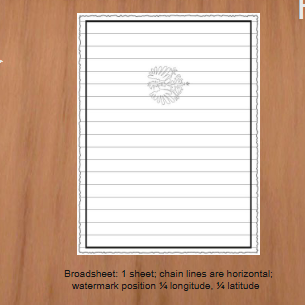
Folio watermark placement
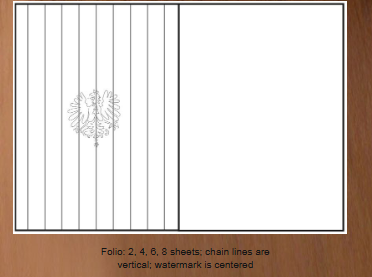
Quarto
Printed four leaves at a time, folded in the middle, turned, and folded again.
A quarto format book’s chainlines will be horizontal and half of the watermark and countermark will emerge roughly half-way down the page in the “gutter” produced by the binding
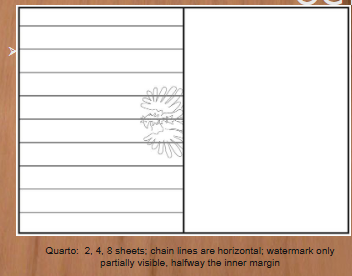
Octavo
Usually printed eight leaves at a time, folded, turned, folded,
turned again, and refolded. Such a “common octavo” gathering must be cut on the top and fore-edge before the gathering can be opened for reading. An octavo format book’s chainlines will be
vertical like a folio’s, but the watermark will not fall in the center, but rather a quarter of it will occur
in a corner of the sheet.
An octavo has 8 leaves (16 pages); watermarks may appear in 8 different locations depending on the pattern...
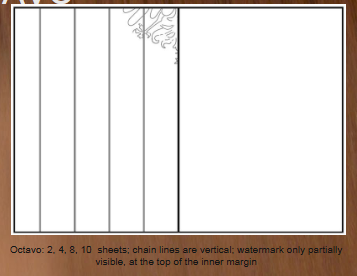
Duodecimo
Printed twelve leaves at a time, and it can be cut and folded
in six different patterns depending on which produced the most finished leaves in the fewest runs
through the press (Gaskell 96-101, Fig. 54-59). Watermarks will be cut in half either on the fore-edge,
at the top of the leaf, or at the top of the gutter
Sextidecimo
Printed sixteen leaves at a time, and can be imposed at
least four different typical ways depending on whether it will be cut on the center line or 1/3 and 2/3, or
cut once, twice or three times (Gaskell 102-5, Fig. 60-63). The resulting book leaves will have the
following chainline-watermark combinations: horizontal and quartered marks at the upper fore-edge
corner (“sixteens”); vertical with the whole mark on one page like a folio but the mark will be nearly as
large as the text block; vertical with half the watermark on the gutter like a quarto but again the mark’s
size will nearly match the text block; horizontal and quartered on the upper corner of the fore-edge like
an octavo, but double-folding of many gatherings should be detectable by their producing eight
conjoined leaves alternating with four-leaf groups (“eights and fours”).
Chain lines vs. wire lines
The thick lines are referred to as the "chain line" and the thin lines the "wire line."
Woodcut
A relief printing in which an image is carved into the surface of a block of wood, with the printing parts remaining level with the surface while the non-printing parts are removed, typically with gouges.
The areas to show “white” are cut away with a knife or chisel, leaving the characters or image to show in “black” at the original surface level.
How to make a woodcut
The block is cut along the grain of the wood (unlike wood
engraving where the block is cut in the end-grain). The surface is
covered with ink by rolling over the surface with an ink-covered
roller (brayer), leaving ink upon the flat surface but not in the
non-printing areas — the result is a marriage between text and illustration never seen before.
What is significant about woodcuts?
Woodcuts were used extensively in the hand-press period, and
represent the first major departure from medieval illustrations
found in manuscript codices, etc.
William Caxton (1420-1491)
The first English person to work as a printer and the first to introduce a printing press into England
First English retailer of printed books
Started the first printing shop in England at Westminster Abbey
Credited with creating The Canterbury Tales, and Le Morte d’Arthur
Wanted to produce works for the laity, not the aristocracy
Printed mainly in English, to stay true to his native language and to avoid competing with Latin books
His English printed books tried to establish that English was a nationwide standard
Sammelbands
Multiple works printed in one volume
Books were rarely bound until the 18th century, so they were just…
sheets of paper. The buyer paid for binding and it was expensive
Do many Sammelbandes exist today?
No
Did single volume books sell better or worse than multivolume ones?
Better
What was the first book Caxton produced?
The Recuyell of the Histories of Troy, which he translated into English — it was the first book to ever be printed in English.
It was a collection of stories based on the Trojan Wars, that was appealing to his readers due to a new typeface he created.
The Canterbury Tales
It’s argued it was from 1476
Anton Koberger
From Nuremberg
Produced the Nuremberg Chronicle, a picture book chronicling the history of the world
It was produced both on vellum and on paper in German and Latin
Sections of the Nuremberg Chronicle
The Liber Chronicarum or Nuremberg
Chronicle, as it is also known, is a universal
history of the Christian world from the
beginning of times to the early 1490s,
written in Latin, dividing earthly history into
six ages:
the First Age of the World from the Creation to
the Deluge
the Second Age from the Deluge to the Birth of
Abraham
the Third Age from the Birth of Abraham to the
Kingdom of David
the Fourth Age from the beginning of the
Kingdom of David to the Babylonian Captivity
the Fifth Age from the Babylonian Captivity to
the Birth of Christ
the Sixth (and longest) Age from the Birth of Christ to 1490s
Accomplishments of the Nuremberg Chronicle
The Nuremberg Chronicle was a complicated endeavor that demanded
substantial planning, and one of the finest illustrated books of the
fifteenth century (incunabula) with illustrations of biblical scenes,
major cities, characters from myths and fables, the genealogical tables
of emperors (see fig. 2), kings and popes as well as maps.
It was the most heavily illustrated book of the entire period.
Liber Chronicarum
The Nuremberg Chronicle
Luremberg Chronicle illustrations and design
Woodblock subjects were sketched at first, then text was inscribed to fit within the remaining page spaces
1,804 illustrations made from 652 woodblocks
Printed on vellum and paper, and typeset in Latin and German
1,300 Latin and 600 German copies were made
Around 1200 survive
Nicolas Jenson
Created Roman type, the first big style after Gutenberg’s blackletter
Clear letters based on straight lines
Lighter and less blocky
“Humanist” style
Also known as Venetian
Big changes on the way
Ethics, poetry, history, rhetoric,
grammar take on great importance
So do acquiring skills to be a good
citizen
Not un-Christian but Christian humanism
Higher literacy rates occur
Vernacular literary culture
The developments of Republics with
Rome as a model
The growth of labor and industry
Each printing occupation worked separately, each belonging to their own guild
Printing brought them together
Book fairs
Interactions between type founders, correctors, translators, copy editors, illustrators or print dealers, indexers, and others who are engaged in editorial work
Sparked creativity and changed the relationship between intellectuals
Collaborations include:
priests, abbots, and printers
astronomers and engravers
physicians and painters
rich merchants and local scholars
Science changes
Scientific research is more collaborative
Results and discoveries were published quickly
Peer review spread the development of ideas
Sharing and widespread availability of information now lead to new scientific discoveries
Printers becoming better educated to suit the needs of their business
No more scribal errors, instead identical copies can now be made
Scientific methods for cataloguing and indexing research now become standard
Benefits of the printing press
An attempt to standardized text, which meant spelling and grammar, fewer mistakes, and the writings of laws
Alphabetical order
Indexes
Books were cheaper
Merchants looked for interesting topics
Paid writers
Varieties of books circulated
Knowledge is much more easily transported due to so many printed copies
New emphasis put on learning
Transition from accepted beliefs to learned ones
Indexing and scientific cataloging develop
Ancient texts become available for reading
Printing was profitable
International exchange of information
Problems with the printing press
Accelerates the growing divide between Protestants and Catholics
Rome censored writers and scared Catholic authors from publishing
People were reading, hearing, and wearing the same things, causing vernaculars to develop
Issues of copyright and plagiarism
Governments began to control printers, restricting the right to print
Special rights to certain publishers to print books
Aldo Manuzio/Auldus Manutius; the Aldine Press (1495-1588)
Most significant press in European history
Aldus Manutius was the first major printer to insist on scholarly editing and produce portable books for scholars
Gathered an army of Greek scholars
Founded an academy of Hellenists called the New Academy
Wanted to make Greek and Roman classics available in print
Made Venice a printing center
The Aldine Press was the first in the
world to issue pocket-sized editions of
books, printed in octavo format.
This new format was revolutionary as it
enabled readers to access books more
easily, rather than having to learn
texts by heart.
The first ever book issued in the
octavo format was this edition of the
works of Virgil, printed in 1501.
Italics
Created by Aldus Manutius, they were a way to fit more words onto a page to save money — today, we use them as design detail or for emphasis
Keys to early english printing processes
The writer/collaborator produces the manuscript using
paper and pen.
2. The writer then submits the manuscript to the Stationers’
Company, which either approves or censors it.
3. The printer purchases the manuscript, hires workers and
gets the supplies (ink/paper/bindings).
1. Typesetters must read the manuscript clearly and
set the type, then lock it up in the press (composing
stick/chase), then ink the presses prior to the start of
printing.
4. Investors (called publishers) pay the printers for
production and distribution to booksellers (warehousing).
5. Booksellers then sell the books at markets, fairs, and in
catalogs.
6. Writers/collaborators ultimately lose all rights to their
manuscripts!!!
Overall takeaways — why and how did the printing press and movable type change everything?
Created an early “global” information network
Carried with it a tremendous amount of learning in the Renaissance
Helped Martin Luther spread Protestantism—which becomes a global
phenomenonFacilitates an explosion of scientific publishing and learning
Gives voices to those who did have one before
Inspires revolution
Improves literacy
Fosters silent reading
Steals jobs from scribes!